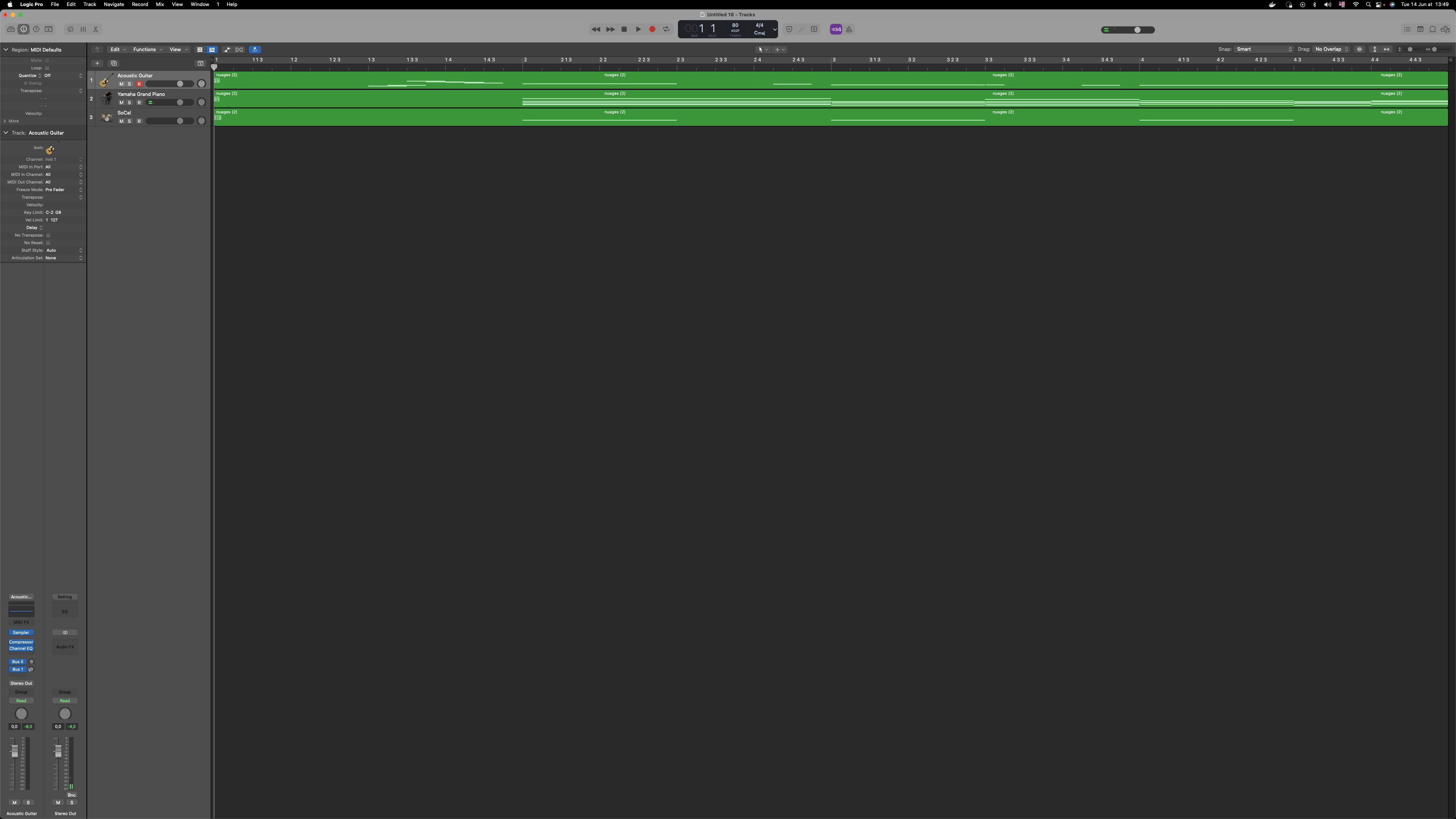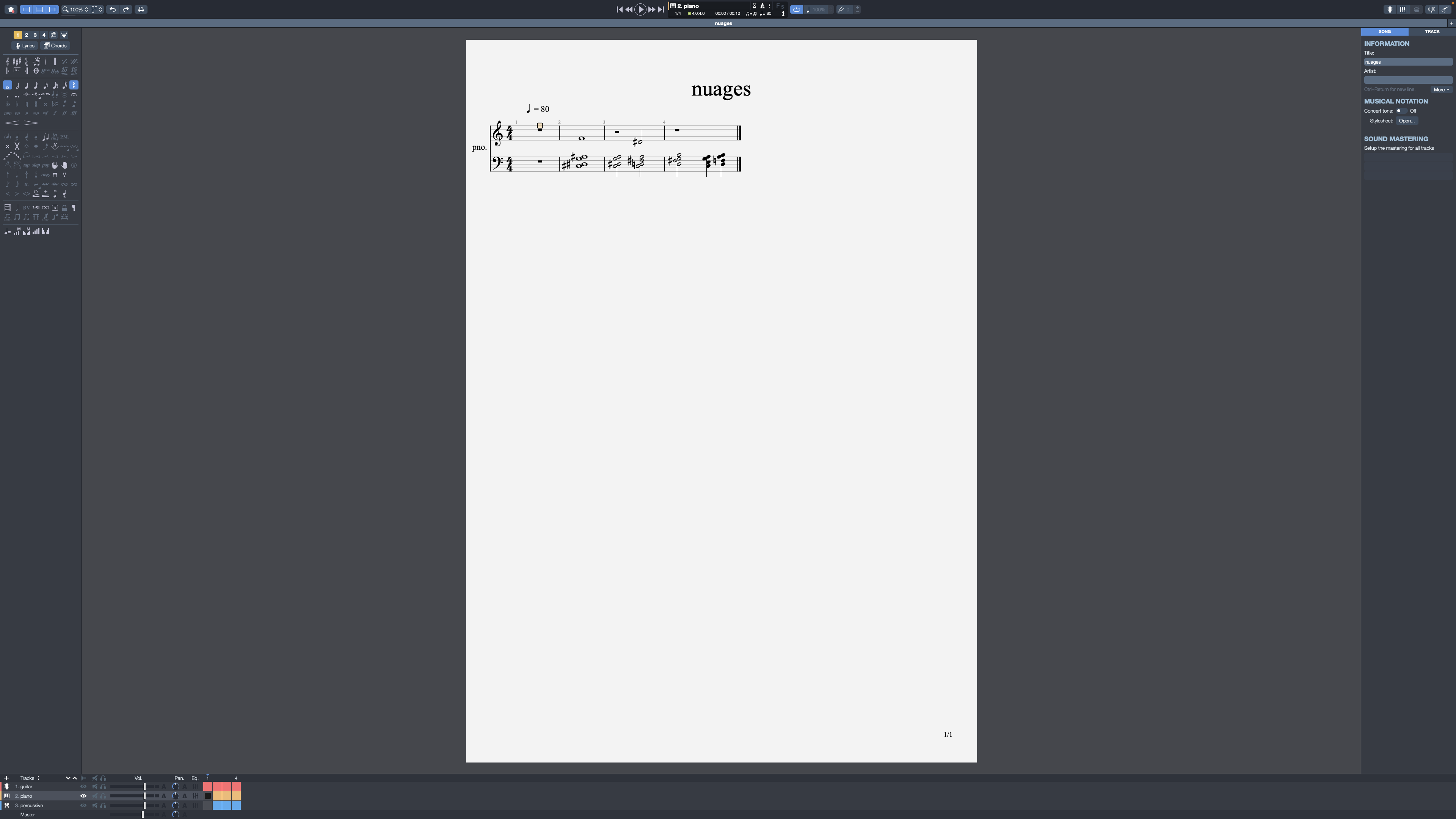June 2022: go-harmony and earmuff

Table of Contents
TL;DR:
did a lot of music, even while writing code.
Code-unrelated work #
As last month, I’ll start with code-unrelated work !
First, here’s my progress on learning Hyunsoo Lee’s adaptation of Bach’s Air on G string, still not quite right and with some missing parts but… slowly getting there:
While at it, I started learning Hyunsoo Lee’s adaptation of Beethovens’ 5th’s Symphony, also not quite right and with missing parts but also making progress:
It was a long time since I made a LoFi track, here’s two that I thought were not too bad:
They’re mostly an exercise to get familiar with Logic Pro X.
go-harmony #
go-harmony is a package written in Golang that intends to implement a music theory engine to build other tools with.
It’s only a month old so there’s not much to it yet,
however there’s enough that I could use it to build the project I’ll talk about in the next section.
My intent was not only to build the engine but also to refresh my memories and fill some gaps… so I decided not to be lazy and copy-paste a bunch of values in static tables. Instead, I first implemented notes, then intervals as semitones distances to a root note, then chords as a pattern of intervals from a root note (taking into account chord inversions), then also scales also as a pattern of intervals, then derived triads and sevenths chords using the chords implementation, and so on…
I made it so it would be very easy to extend for unsupported cases, like chords which are defined as follows making it simple to add new families by simply describing the general structure:
MajorTriad Structure = Structure{
intervals.PerfectUnison,
intervals.MajorThird,
intervals.PerfectFifth,
}
MinorTriad Structure = Structure{
intervals.PerfectUnison,
intervals.MinorThird,
intervals.PerfectFifth,
}
AugmentedTriad Structure = Structure{
intervals.PerfectUnison,
intervals.MajorThird,
intervals.AugmentedFifth,
}
DiminishedTriad Structure = Structure{
intervals.PerfectUnison,
intervals.MinorThird,
intervals.DiminishedFifth,
}
[...]
AddNinth Structure = append(MajorTriad, intervals.MajorNinth)
AddEleventh Structure = append(MajorTriad, intervals.PerfectEleventh)
AddThirteenth Structure = append(MajorTriad, intervals.MajorThirteenth)
SusSecond Structure = Structure{
intervals.PerfectUnison,
intervals.MajorSecond,
intervals.PerfectFifth,
}
SusFourth Structure = Structure{
intervals.PerfectUnison,
intervals.PerfectFourth,
intervals.PerfectFifth,
}
The same applies for scales:
var Ionian = []intervals.Interval{
intervals.PerfectUnison,
intervals.MajorSecond,
intervals.MajorThird,
intervals.PerfectFourth,
intervals.PerfectFifth,
intervals.MajorSixth,
intervals.MajorSeventh,
intervals.Octave,
}
var Dorian = []intervals.Interval{
intervals.PerfectUnison,
intervals.MajorSecond,
intervals.MinorThird,
intervals.PerfectFourth,
intervals.PerfectFifth,
intervals.MajorSixth,
intervals.MinorSeventh,
intervals.Octave,
}
[...]
var BluesMajor = []intervals.Interval{
intervals.PerfectUnison,
intervals.MajorSecond,
intervals.PerfectFourth,
intervals.PerfectFifth,
intervals.MajorSixth,
intervals.Octave,
}
var MinorPentatonic = []intervals.Interval{
intervals.PerfectUnison,
intervals.MinorThird,
intervals.PerfectFourth,
intervals.PerfectFifth,
intervals.MinorSeventh,
intervals.Octave,
}
Then go-harmony uses artihmetics to compute everything from a root note and its intervals.
For example the scale.Notes() method computes the notes for a scale by applying the intervals that match the scale pattern for a given root note:
func (scale *Scale) Notes() []notes.Note {
ret := make([]notes.Note, 0)
for _, interval := range scale.structure {
ret = append(ret, *scale.root.Interval(interval))
}
return ret
}
No hard-coded scales for each notes and once a scale structure is implemented, it works for all notes.
The package by itself doesn’t do much more, it’s meant to provide APIs and structures for other projects to rely upon, however I built a small utility that’s shipped with it to showcase some of it’s features.
For example, it can be used to validate note names and obtain their frequencies relative to a particular tuning (only A440 for now):
% harmony -note 'C'
C 261.63
% harmony -note 'C5'
C 523.25
% harmony -note 'A'
A 440
% harmony -note 'Cb'
Cb 493.88
% harmony -note 'C#'
C# 277.18
% harmony -note 'Cbb'
Cbb 466.16
% harmony -note Z
2022/06/14 13:25:36 bad note (Z): should be 'C', 'D', 'E', 'F', 'G', 'A' or 'B'
Just as with notes, it can be used to validate chord names (it supports multiple notations) and decompose them into their building intervals:
% harmony -chord 'C'
Cmaj
1: C 261.63
3maj: E 329.63
5: G 392.00
% harmony -chord 'C5'
C5
1: C 261.63
5: G 392.00
% harmony -chord 'C7'
C7
1: C 261.63
3maj: E 329.63
5: G 392.00
7min: Bb 466.16
% harmony -chord 'C7b5'
C7dim5
1: C 261.63
3maj: E 329.63
5dim: Gb 369.99
7min: Bb 466.16
% harmony -chord 'Csus2'
Csus2
1: C 261.63
2maj: D 293.66
5: G 392.00
% harmony -chord 'Cadd9'
Cadd9
1: C 261.63
3maj: E 329.63
5: G 392.00
9maj: D 587.33
% harmony -chord 'Cadd9/E'
Cadd9/E
3maj: E 329.63
1: C 261.63
5: G 392.00
9maj: D 587.33
% harmony -chord 'Cadd2'
2022/06/14 13:24:43 unknown chord name: add2
It knows of a few scales and modes and can decompose them into notes, triads and sevenths chords for each degree of the scale:
% harmony -scale Caeolian
C
C 261.63
D 293.66
Eb 311.13
F 349.23
G 392
Ab 415.3
Bb 466.16
C 523.25
Triads:
Cmin
Ddim
Ebmaj
Fmin
Gmin
Abmaj
Bbmaj
Sevenths:
Cmin7
Dm7b5
Ebmaj7
Fmin7
Gmin7
Abmaj7
Bb7
% harmony -scale Cphrygian
C
C 261.63
Db 277.18
Eb 311.13
F 349.23
G 392
Ab 415.3
Bb 466.16
C 523.25
Triads:
Cmin
Dbmaj
Ebmaj
Fmin
Gdim
Abmaj
Bbmin
Sevenths:
Cmin7
Dbmaj7
Eb7
Fmin7
Gm7b5
Abmaj7
Bbmin7
And finally, someone asked if it could build chords from a given set of notes, so I implemented it which took only a couple minutes:
% harmony -notes 'C,E,G'
Cmaj
C 261.63
E 329.63
G 392
% harmony -notes 'C,Eb,G,B'
C-M7
C 261.63
Eb 311.13
G 392
B 493.88
% harmony -notes 'C,Eb,G,Bb'
Cmin7
C 261.63
Eb 311.13
G 392
Bb 466.16
% harmony -notes 'C,F,G'
Csus4
C 261.63
F 349.23
G 392
That’s about all it can do for now, but I have many ideas I want to implement as I have big plans for it :-)
earmuff #
earmuff is a proof-of-concept compiler and interpreter for a programming language to write music.
After I showed the first iteration of the interpreter,
two people pointed me to Sonic Pi and it kinda is a similar concept but executed a bit differently.
Whereas Sonic Pi’s is an advanced scriptable synthesizer with its own IDE,
earmuff is simply a language to express music sheet as code and doesn’t come with anything but the interpreter and compiler for it.
My intent was to be able to write music as code in my usual programming environment,
using diff, patch or even git for versionning my changes and applying new changes,
and basically work with music in the same way I work with code when I don’t have instruments at hands.
So earmuff reads .muff source files,
and either compiles them to SMF (Standard Midi File) files that can be played with a standard MIDI player,
or interprets them into MIDI messages that are sent to a synthesizer to play the source code in real-time.
It relies on go-harmony to make sense of notes and chord names,
spotting errors as it converts the source code to its internal format,
and validating that the tracks are structurally consistent (ie: time signature violations) just as if it was checking for syntax or grammar errors.
A .muff file may look like this for a single-track 12-bars blues:
project {
bpm 120;
time 4 4;
instrument guitar {
bar { whole chord C7 on 1/1; }
bar { whole chord F7 on 1/1; }
bar { whole chord C7 on 1/1; }
bar { whole chord C7 on 1/1; }
bar { whole chord F7 on 1/1; }
bar { whole chord F7 on 1/1; }
bar { whole chord C7 on 1/1; }
bar { whole chord C7 on 1/1; }
bar { whole chord G7 on 1/1; }
bar { whole chord F7 on 1/1; }
bar { whole chord C7 on 1/1; }
bar { whole chord G7 on 1/1; }
}
}
… or may be more complex for multi-tracks projects, like these few bars from Django’s Nuages (I know, it’s not quite right but hey, it was late and I’m still learning the language 😅):
project {
bpm 80;
time 4 4;
instrument guitar {
bar {
8th note C# on 3/1;
8th note D on 3/2;
8th note A on 3/3;
8th note G# on 3/4;
8th note G on 4/1;
8th note F# on 4/2;
}
bar {
half note F on 1/1;
8th note E on 4/2;
}
bar {
half note Fbb on 1/1;
quarter note Eb on 2/2;
8th note D on 4/2;
}
bar { whole note D on 1/1; }
}
instrument piano {
bar {}
bar { whole chord Eb9 on 1/1; }
bar {
half chord Am7b5 on 1/1;
half chord D7b9 on 3/1;
}
bar {
half chord Gmaj7 on 1/1;
quarter chord Am7 on 3/1;
quarter chord Bm7b5 on 4/1;
}
}
instrument percussive {
bar {}
bar { half cymbal on 1/1; }
bar { half cymbal on 1/1; }
bar { half cymbal on 1/1; }
}
}
By default,
earmuff operates as an interpreter so running the following command will playback the source if a synthesizer is detected (currently only FluidSynth is):
% earmuff nuages.muff
The -verbose option may be passed,
in which case earmuff outputs MIDI messages being sent to the synthesizer in real-time for debugging:
synth <- 0 ProgramChange channel: 0 program: 25
synth <- 2 ProgramChange channel: 10 program: 113
synth <- 1 ProgramChange channel: 1 program: 1
synth <- 0 NoteOn channel: 0 key: 49 velocity: 120
synth <- 0 NoteOn channel: 0 key: 50 velocity: 120
synth <- 0 NoteOn channel: 0 key: 57 velocity: 120
synth <- 0 NoteOff channel: 0 key: 49
synth <- 0 NoteOn channel: 0 key: 56 velocity: 120
synth <- 0 NoteOff channel: 0 key: 50
synth <- 0 NoteOff channel: 0 key: 57
synth <- 0 NoteOn channel: 0 key: 55 velocity: 120
synth <- 0 NoteOff channel: 0 key: 56
synth <- 0 NoteOn channel: 0 key: 54 velocity: 120
synth <- 0 NoteOff channel: 0 key: 55
synth <- 0 NoteOff channel: 0 key: 54
synth <- 2 NoteOn channel: 10 key: 51 velocity: 120
synth <- 1 NoteOn channel: 1 key: 51 velocity: 120
synth <- 1 NoteOn channel: 1 key: 49 velocity: 120
synth <- 0 NoteOn channel: 0 key: 53 velocity: 120
synth <- 1 NoteOn channel: 1 key: 55 velocity: 120
synth <- 1 NoteOn channel: 1 key: 65 velocity: 120
synth <- 1 NoteOn channel: 1 key: 58 velocity: 120
Passing the option -out will cause it to compile a .mid file:
% earmuff -out nuages.mid nuages.muff
… which can either be played by a standart MIDI player, imported in tools that can ingest MIDI files such as a DAWs (here Logic Pro X):

… or tools like Guitar Pro which can render sheet music from a MIDI file, play it back after altering speed, instruments, etc…

This is a toy project at a very early stage, I don’t have very serious plans for it but I’ll keep working on it as it improves my overall knowledge, and I kinda like the idea of being able to write music as code from my bed while the kid sleeps by my side (also I’m far faster as writing code than editing sheets) :-)
There are still bugs and glitches in the MIDI generation but the MP3 I linked above was converted from the .mid built by the source code just above it, so it may not be perfect yet but it works pretty decently in my opinion.
My current plans are to cleanup the proof-of-concept,
make it work on at least macOS, Windows, Linux and OpenBSD,
and then extend it with new features such as loops and functions.
A very nice feature would be to allow it to read from MIDI and generate the corresponding .muff code,
allowing me to auto-generate code from a MIDI input (like a keyboard for example),
or simply allowing me to export a SMF from another tool to work on it with earmuff and export it back to the other tool:
being able to switch back and forth between VScode and Guitar Pro or Logic Pro X would be awesome.
What’s next ? #
Next is A DAMN BREAK cause I said last month I’d take a couple months and couldn’t even hold my word for a single one. I’ll be marrying in a couple weeks, going on vacations a few weeks later, and got plenty of code-unrelated things to finish.
Take care, stay tuned, I’ll post as soon as I resume my work !
